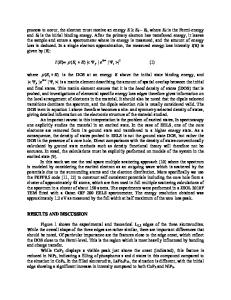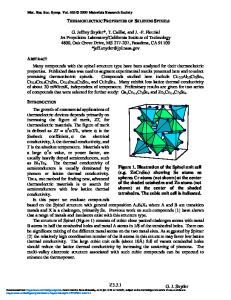Thermoelectric and structural properties of high-performance In-based skutterudites for high-temperature energy recovery
- PDF / 502,405 Bytes
- 9 Pages / 584.957 x 782.986 pts Page_size
- 62 Downloads / 849 Views
Morris S. Good and Kamandi C. Roberts Pacific Northwest National Laboratory, Richland, Washington 99352
M.A. Subramanian Department of Chemistry, Oregon State University, Corvallis, Oregon 97331
Terry J. Hendricksa) Pacific Northwest National Laboratory, MicroProducts Breakthrough Institute, Corvallis, Oregon 97330 (Received 22 December 2010; accepted 22 April 2011)
The temperature-dependent thermoelectric (TE) and structural properties of n-type filled skutterudites were measured from 300–625 K. In0.2Co4Sb12, and In0.2Ce0.05Yb0.1Co4Sb12 exhibited figure of merit (ZT) values as high as 1.2 at 625 K and In0.2Ce0.15Co4Sb12 showed ZT values of ;1.4 at 625 K. The room temperature Young’s modulus, Poisson’s ratio, and coefficient of thermal expansion (at 298– 673 K) of In0.2Ce0.15Co4Sb12, In0.2Co4Sb12, and In0.2Ce0.05Yb0.1Co4Sb12 compositions were found to be lower than that for the unfilled Co4Sb12 skutterudite material. It was discovered that thermal cycling of n-type In0.15Ce0.1Co4Sb12 and In0.2Ce0.17Co4Sb12 materials from 323–673 K (200 cycles) actually increased their power factors by 13.6–36% at 510–525 K without appreciably changing the Young’s modulus or the Poisson’s ratio. The transport and structural properties characterized in this work are critical to transitioning these materials into operating TE devices and systems.
I. INTRODUCTION
The U.S. Department of Energy (DOE) Transportation Energy Data Book: Edition 24 shows that in 2002 ;130 billion gallons of gasoline was used nationwide by light-duty passenger cars, minivans, and sport utility vehicle segment. Some estimates indicate that ;4-5 Quads (1 Quad 5 1015 Btu) of the energy in this fuel ended up as waste thermal energy in vehicle exhaust streams. The same reference indicates another ;30 billion gallons of diesel fuel was used nationwide by heavy-duty vehicles in 2002, of which ;1.4 Quads of the energy in this fuel ended up as waste thermal energy in heavy-vehicle exhaust streams. In 2008, ;4.7 Quads (;20%) of transportation sector fuel energy was used to operate heavy-duty, Class 8 vehicles; with ;1.6 Quads of this energy ending up in heavy vehicle high-temperature exhaust flows. The DOE Office of Vehicle Technologies is sponsoring research to develop advanced, high-temperature n-type and p-type skutterudite thermoelectric (TE) materials to harness this exhaust flow energy enabling higher energy efficiency in heavy-duty a)
Address all correspondence to this author. e-mail: [email protected] DOI: 10.1557/jmr.2011.163 J. Mater. Res., Vol. 26, No. 15, Aug 14, 2011
and light-duty vehicle engines. The work leverages recent advanced TE materials research in skutterudites, quantum well, and nanostructured materials to recover and convert this waste thermal energy into high-grade electrical energy onboard the vehicle. Advanced TE materials are critical to achieving project performance goals and introducing other potential future applications of TE power generation and advanced cooling in vehicle systems. The temperature range of interest in automotive wast
Data Loading...











